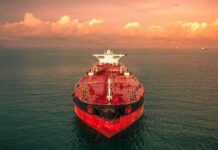
The global container shipping industry stands at a technological crossroads in 2025. As vessels grow larger, supply chains more complex, and environmental regulations more stringent, shipping companies face unprecedented pressure to improve efficiency, reduce emissions, and enhance transparency across operations.
Artificial intelligence (AI) has emerged as the definitive solution to these challenges, with leading carriers investing heavily in digital transformation. From autonomous navigation systems to predictive maintenance and dynamic route optimisation, AI is no longer just a competitive advantage—it’s becoming essential for survival in the modern maritime landscape.
The Digital Imperative for Container Shipping
The container shipping industry has traditionally been conservative in adopting new technologies. However, several factors are now accelerating digital transformation:
- Rising operational costs from fuel, labour, and regulatory compliance
- Environmental regulations requiring better emissions monitoring and reduction
- Supply chain disruptions highlighting the need for more resilient operations
- Customer expectations for real-time visibility and transparent pricing
- Competition from tech-enabled logistics startups disrupting traditional business models
The stakes are significant. According to McKinsey research, shipping companies implementing comprehensive digital strategies are achieving operational cost reductions of 15-20% while simultaneously improving service quality and reliability.
Seven Key AI Applications Transforming Container Shipping
- Predictive Maintenance and Asset Management
AI-powered predictive maintenance systems are revolutionising how shipping companies manage their fleets. By analysing data from thousands of sensors throughout vessels, these systems can identify potential equipment failures before they occur.
Leading carriers are implementing digital twins—virtual replicas of physical assets—to monitor everything from engine performance to hull integrity in real-time. The result: reduced downtime, extended equipment life, and significant maintenance cost savings.
- Route Optimisation and Fuel Efficiency
AI algorithms now process vast amounts of data—including weather patterns, ocean currents, port congestion, and fuel consumption metrics—to determine optimal routes. These systems continuously adapt to changing conditions, allowing vessels to:
- Avoid adverse weather conditions
- Reduce fuel consumption
- Minimise transit times
- Decrease emissions
One major European carrier reported fuel savings of 12% after implementing AI-based route optimisation, translating to millions in cost reduction and substantial emissions decreases.
- Port Operations and Terminal Management
Ports and terminals represent critical bottlenecks in global supply chains. AI is streamlining these operations through:
- Berth planning optimisation that reduces vessel waiting times
- Automated container handling via AI-guided cranes and vehicles
- Predictive congestion management that forecasts peak periods
- Dynamic resource allocation for labour and equipment
The Port of Rotterdam’s implementation of AI-driven port management systems has increased container handling efficiency by 20%, significantly reducing vessel turnaround times.
- Supply Chain Visibility and Logistics Coordination
Perhaps the most transformative application of AI in shipping is in creating end-to-end supply chain visibility. Machine learning models now integrate data from carriers, terminals, customs authorities, and inland transportation providers to offer unprecedented transparency.
These systems can predict potential disruptions days or weeks in advance, allowing for proactive mitigation strategies rather than reactive problem-solving. For beneficial cargo owners, this means fewer surprises, better inventory management, and more resilient supply chains.
- Dynamic Pricing and Capacity Management
Traditional container shipping pricing models are being replaced by AI-driven systems that consider:
- Real-time supply and demand conditions
- Vessel utilisation forecasts
- Seasonal trends
- Competitive pricing data
- Customer value metrics
These systems help carriers maximise revenue while offering more personalised pricing to shippers based on their specific needs and shipping patterns.
- Autonomous and Semi-Autonomous Vessels
While fully autonomous ocean-going container vessels remain on the horizon, semi-autonomous systems are already being deployed. These technologies handle routine navigation tasks, collision avoidance, and vessel positioning, allowing crew to focus on more complex operations and emergency management.
By 2025, several short-sea shipping routes have begun implementing autonomous vessel technologies, paving the way for broader adoption in coming years.
- Emissions Monitoring and Environmental Compliance
AI systems are proving invaluable for environmental compliance in an era of increasing regulation. Real-time emissions monitoring, coupled with predictive analytics, helps vessels:
- Optimise fuel consumption patterns
- Ensure compliance with regional and international regulations
- Document and report emissions accurately
- Identify opportunities for further environmental improvements
https://www.youtube.com/watch?v=KkjCrMNueSc
Implementation Challenges: Why Digital Transformation Still Lags
Despite clear benefits, many shipping companies struggle to fully implement AI and digital technologies. Common barriers include:
Data Quality and Integration Issues
AI systems are only as good as the data that feeds them. Many shipping companies operate with fragmented data across disparate systems, making integration difficult. Historical data quality issues further complicate matters, requiring significant cleanup before AI implementations can deliver accurate results.
Legacy Systems and Technical Debt
The shipping industry operates on numerous legacy systems that were never designed for integration with modern AI applications. Replacing these systems requires substantial investment and carries operational risk during transition periods.
Cybersecurity Concerns
As vessels and operations become more connected, cybersecurity emerges as a critical concern. The potential for system breaches presents significant risks to both operational safety and business continuity.
Skills Gap and Organisational Culture
Perhaps the most challenging barrier is the human element. Many shipping organisations lack the digital skills needed to implement and maintain advanced AI systems. Cultural resistance to technology-driven change further complicates digital transformation efforts.
Building a Successful AI Implementation Strategy
For shipping companies looking to accelerate their digital transformation, a structured approach is essential:
- Start with Clear Business Objectives
Successful AI implementation begins with well-defined business problems rather than technology for technology’s sake. Identify specific operational challenges where AI can deliver measurable improvements, then build solutions around these use cases.
- Invest in Data Infrastructure
Before implementing advanced AI applications, establish robust data collection, cleaning, and storage capabilities. This foundation is essential for any successful AI initiative.
- Adopt a Modular Approach
Rather than attempting comprehensive transformation all at once, implement AI solutions in modules that can deliver immediate value while building toward a more integrated future state.
- Build Digital Skills and Culture
Invest in training and development to build digital capabilities throughout the organisation. Create internal champions who can drive adoption and demonstrate the value of new technologies.
- Partner with Technology Specialists
Few shipping companies have the internal resources to build sophisticated AI solutions independently. Strategic partnerships with technology providers can accelerate implementation and reduce risk.
The Path Forward: Digital Transformation as Competitive Necessity
The shipping companies that emerge as leaders in the coming years will be those that successfully navigate the digital transformation journey. As AI technologies mature and implementation barriers fall, the gap between digital leaders and laggards will widen.
For container shipping executives, the question is no longer whether to invest in AI and digital transformation, but how quickly and effectively they can implement these technologies to remain competitive in an increasingly digital industry.
By embracing AI-powered solutions across operations, forward-thinking shipping companies can simultaneously reduce costs, improve service quality, and minimise environmental impact—creating sustainable competitive advantage in a challenging market environment.
——————————————————————————————————
ProfileTree, a leading digital agency based in Belfast, Northern Ireland, specialises in AI implementation and web development services for the shipping and logistics sector. Our team of experts helps companies navigate digital transformation through custom AI solutions, data integration platforms, and advanced web applications designed specifically for maritime operations. Contact us to learn how we can support your company’s digital journey.





